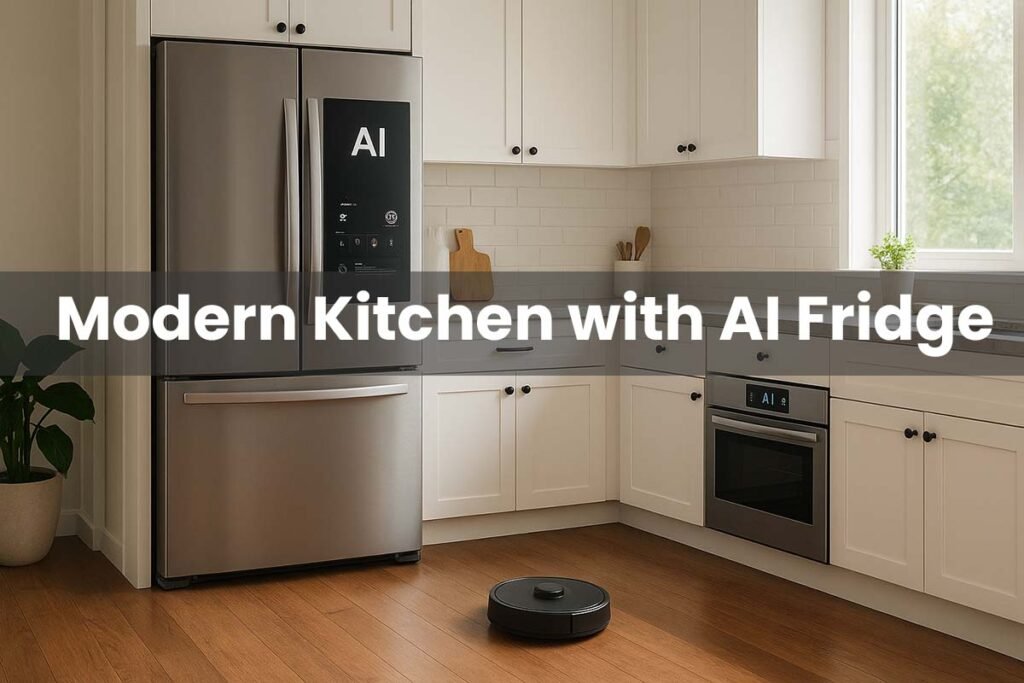Picture this: You’re rushing out the door in your New York apartment, and your smart thermostat has already adjusted the temperature to save energy while you’re away. Or imagine your fridge in a cozy Chicago home reminding you to buy milk before it runs out—based on your shopping habits. Artificial intelligence (AI) isn’t just powering futuristic robots anymore; it’s woven into the gadgets we use every day, making life in the US simpler, safer, and more efficient.
But with so many smart devices flooding the market—from voice assistants to wearable health trackers—how do you know which ones are worth the hype? In a country where busy lifestyles in cities like Los Angeles or rural areas in Texas demand convenience without complexity, AI gadgets can be game-changers. This guide explores the most practical AI-powered devices for everyday Americans, breaking down how they work, why you need them, and real tips to integrate them seamlessly. Whether you’re a parent juggling work in Atlanta or a retiree in Florida seeking easier living, let’s uncover the smart tech that’s truly essential in 2025.
What Makes a Gadget “AI-Powered”?
At its core, an AI-powered gadget uses artificial intelligence to learn from data, make decisions, and adapt over time—going beyond simple programming. In the US, where consumers value innovation and convenience, these devices stand out by predicting needs and automating routines.
Key Elements:
- Machine Learning: Gadgets “learn” from your habits, like a thermostat adjusting based on your schedule.
- Natural Language Processing (NLP): Enables voice commands, as seen in assistants understanding accents from Boston to Texas.
- Sensors and Data Integration: Collects info from your environment (e.g., motion, temperature) to act intelligently.
- Connectivity: Links with other devices via Wi-Fi or Bluetooth for a seamless “smart ecosystem.”
Unlike basic electronics, AI gadgets evolve—your coffee maker might start brewing at 7 AM after noticing your morning routine. This personalization is why they’re booming in American households, per a 2025 Consumer Reports survey showing 45% of US adults own at least one.
Why AI Gadgets Are Taking Over American Homes
From bustling urban centers to quiet suburbs, AI gadgets address real pain points in US daily life. High energy costs in states like California? AI thermostats cut bills. Long commutes in traffic-heavy Atlanta? Smart assistants provide hands-free updates. The pandemic accelerated adoption, with Statista reporting over 100 million smart homes in the US by 2025.
Driving Factors:
- Convenience: Automate chores, saving time for work or family.
- Cost Savings: Reduce utility bills and waste—AI fridges minimize food spoilage.
- Safety and Security: Real-time alerts protect homes in hurricane-prone Florida or wildfire-risk California.
- Health Focus: Wearables track wellness, aligning with Americans’ emphasis on fitness post-COVID.
- Sustainability: Eco-friendly features appeal to environmentally conscious consumers in places like Portland.
Transitioning from why to what, let’s spotlight the must-have devices making waves.
Top AI Smart Home Devices You Need
Voice Assistants and Smart Speakers
These are the hubs of smart homes, responding to voice commands and controlling other devices.
- Amazon Echo (Alexa): Learns your preferences for music, news, or shopping lists—perfect for busy parents in suburban Chicago.
- Google Nest Hub: Integrates with calendars and traffic updates, ideal for remote workers in Seattle checking commutes.
- Apple HomePod: Focuses on privacy and sound quality, syncing seamlessly with iPhones for East Coast professionals.
Bullet Points: Daily Uses
- Set reminders for virtual meetings.
- Control lights or thermostats hands-free.
- Play podcasts during your morning routine.
Intelligent Thermostats and Energy Savers
AI thermostats learn your habits to optimize heating/cooling, saving on utility bills amid rising US energy costs.
- Nest Learning Thermostat: Adjusts based on occupancy and weather—users report 10–15% savings per year.
- Ecobee SmartThermostat: Uses room sensors and geofencing to fine-tune comfort, great for large homes in Texas.
- Honeywell Home T9: Predicts preferences and integrates with voice assistants for effortless control.
Table: Thermostat Comparison
| Device | Key AI Feature | Energy Savings | Price Range |
|---|---|---|---|
| Nest Learning | Habit-based scheduling | 10–15% | $249 |
| Ecobee | Multi-room sensing | 23% | $249 |
| Honeywell T9 | Geofencing & predictions | 15–20% | $199 |
AI-Enabled Security Systems
Peace of mind is priceless, especially in urban areas like New York or rural spots with limited neighbors.
- Ring Video Doorbell Pro: AI detects people vs. animals, reducing false alerts.
- Arlo Ultra 2: Facial recognition and activity zones for customized notifications.
- SimpliSafe: AI analyzes patterns to alert on unusual activity, integrating with smart locks.
Numbered List: Setup Tips
- Position cameras for optimal coverage.
- Customize AI alerts to your routine.
- Link with apps for remote monitoring.
These devices are transforming how Americans secure their homes, with a focus on privacy in post-data-breach aware society.
Wearable AI Gadgets for Health and Fitness
Wearables are booming in the US fitness culture, from gym enthusiasts in LA to hikers in Colorado.
Smartwatches and Fitness Trackers
- Apple Watch Series 10: AI analyzes heart rate, sleep, and activity to suggest personalized workouts.
- Fitbit Sense 2: Stress management with AI-driven breathing exercises and health insights.
- Garmin Vivosmart 5: Predicts energy levels and recovery needs for optimal training.
Bullet Points: Health Benefits
- Track steps, calories, and sleep patterns.
- Get reminders to move or hydrate.
- Integrate with apps for diet tracking.
AI Hearing Aids and Health Monitors
- Oticon More: AI enhances speech clarity in noisy environments, like crowded Boston subways.
- Withings ScanWatch: Monitors heart health with AI alerts for irregularities, popular among older adults in Florida.
- Oura Ring: Tracks sleep and readiness scores, helping shift workers in Vegas maintain balance.
Table: Wearable Comparison
| Device | Focus Area | AI Highlight | Price |
|---|---|---|---|
| Apple Watch | Overall Fitness | Personalized coaching | $399+ |
| Fitbit Sense | Stress & Wellness | EDA sensor insights | $249 |
| Oura Ring | Sleep & Recovery | Readiness predictions | $299 |
These gadgets empower users to take proactive health steps, aligning with America’s wellness trends.
AI in Kitchen and Household Appliances
AI makes household chores effortless, saving time for busy families in states like Texas or California.
Smart Refrigerators and Ovens
- Samsung Family Hub: AI scans contents, suggests recipes, and creates shopping lists via app.
- LG ThinQ Oven: Learns cooking preferences and adjusts settings for perfect results.
- Bosch Smart Fridge: Monitors expiration dates and notifies you—reducing food waste.
Robotic Vacuums and Cleaners
- iRobot Roomba j7+: AI avoids obstacles and maps your home for efficient cleaning.
- Ecovacs Deebot: Self-empties and adapts to floor types, ideal for pet owners in suburban homes.
- Shark IQ Robot: Schedules based on your routine, learning high-traffic areas.
Numbered List: Kitchen AI Hacks
- Use fridge cams to check groceries remotely.
- Set oven preheats via voice from another room.
- Program vacuums for post-dinner cleanups.
These free up time for what matters, like family dinners or side hustles.
AI Gadgets for Entertainment and Connectivity
Entertainment in the US is all about streaming and smart homes.
Smart TVs and Streaming Devices
- Samsung Neo QLED: AI upscales content for better picture quality and recommends shows based on viewing history.
- Roku Ultra: Suggests personalized content across services like Netflix and Hulu.
- Amazon Fire TV Cube: Voice-controlled with AI for faster searches and ambient lighting sync.
AI-Powered Routers and Wi-Fi Systems
- Google Nest Wifi: Optimizes bandwidth for video calls, gaming, or streaming without lag.
- Netgear Orbi: AI detects interference and boosts signals for large homes.
- Eero Pro 6: Self-healing network that reroutes traffic if a node fails.
Bullet Points: Connectivity Wins
- Seamless streaming for binge-watching nights.
- Prioritized bandwidth for work calls.
- Easy setup for non-tech-savvy users.
Real-Life Examples and Case Studies
Case Study 1: Family in Seattle
The Johnsons use Nest Thermostat and Roomba to manage their busy household. “AI saves us $50/month on energy and frees weekends from cleaning,” says mom Lisa. Their energy bill dropped 18% in 2025.
Case Study 2: Retiree in Florida
Mr. Ramirez, 72, relies on Apple Watch for health alerts and Ring for security. “It caught a porch pirate last month—AI sent instant notifications,” he shares. His doctor praises the proactive monitoring.
Case Study 3: Young Professional in NYC
Apartment-dweller Sofia integrates Samsung Hub with her fridge and TV. “AI suggests quick recipes after long workdays—it’s like having a personal assistant,” she says. Meal prep time halved.
Example: Rural Texas Rancher
Using Garmin for livestock monitoring and Ecobee for barn climate control, a farmer prevents losses from weather changes, boosting efficiency by 25%.
These stories highlight AI’s practical impact across diverse US lifestyles.

Benefits of Integrating AI Gadgets into Daily Life
- Time Savings: Automate routines, freeing hours for leisure or work.
- Cost Efficiency: Lower bills through optimized energy use and waste reduction.
- Enhanced Safety: Real-time alerts prevent accidents or intrusions.
- Health Improvements: Proactive monitoring encourages better habits.
- Convenience: Voice control and personalization make life effortless.
Expert Tip: “AI gadgets shine when connected—start with a hub like Alexa to unify your setup,” advises tech reviewer Mark Johnson from Wired.
Potential Drawbacks and How to Address Them
Drawbacks
- Privacy Concerns: Devices collect data—risk of hacks.
- High Initial Cost: Premium gadgets can exceed $200.
- Tech Overload: Too many can complicate life.
- Reliability Issues: Wi-Fi dependency in rural areas.
How to Address
- Choose devices with strong encryption (e.g., Apple’s ecosystem).
- Start budget-friendly—buy one at a time.
- Limit to essentials to avoid clutter.
- Use mesh networks for better coverage in remote spots.
Transitioning carefully ensures benefits outweigh downsides.
Expert Opinions: What Tech Leaders Say
“In the US, AI gadgets are democratizing smart living—from urban apartments to rural farms, making efficiency accessible to all.”
— Sarah Lee, Consumer Tech Analyst, CNET
“The real power is in integration—devices that learn together create a truly intuitive home.”
— Dr. Raj Patel, AI Researcher, Stanford
“Focus on privacy-first brands; Americans value control over their data as much as convenience.”
— Emily Torres, Privacy Advocate, EFF
How to Choose and Set Up AI Gadgets
- Assess Needs: Urban dweller? Prioritize security. Family home? Go for kitchen aids.
- Research Compatibility: Ensure devices work with your phone/OS (iOS/Android).
- Budget Wisely: Start under $100 (e.g., basic Echo Dot).
- Set Up Securely: Use strong passwords and two-factor authentication.
- Test and Expand: Begin with one, add more as you see value.
- Stay Updated: Enable auto-updates for latest AI features.
Bullet Points: US Buying Tips
- Check reviews on Amazon or Best Buy for real user feedback.
- Look for energy rebates in states like California.
- Opt for brands with strong US customer support.
Embrace the Smart Future
AI in everyday gadgets isn’t about flashy tech—it’s about making life in the US more manageable, from the bustling streets of Manhattan to the quiet suburbs of Ohio. These smart devices save time, cut costs, enhance safety, and even boost health, all while adapting to your unique needs. As we’ve seen through examples and expert insights, the key is choosing wisely and integrating thoughtfully.
Don’t let the future pass you by. Pick one gadget that solves a daily hassle, set it up this weekend, and experience the difference. What’s your must-have AI device? Share in the comments, and subscribe for more guides on tech that fits real American lives!
FAQ: AI in Everyday Gadgets
Q1: Are AI gadgets secure for home use?
A1: Yes, with built-in encryption and updates from reputable brands—always enable privacy settings.
Q2: Which smart device is best for beginners?
A2: Start with a voice assistant like Amazon Echo—easy setup and versatile for most homes.
Q3: Do these gadgets work without internet?
A3: Some functions need Wi-Fi, but many have offline modes for basics like alarms or local controls.
Q4: How much do they cost to run?
A4: Minimal—most use low energy, and AI optimization can actually lower your utility bills.
Q5: Can AI gadgets help with energy savings?
A5: Absolutely—thermostats like Nest learn your habits to reduce heating/cooling costs by 10–20%.




Pingback: Top Free AI Courses and Certifications Online for Beginners in 2025 - FirstsPost